Pet rats are often recommended as one of the best pocket pets for kids and adults alike. Given the name of this website I’m pretty biased, but I can forgive you for considering other pets!
Some of the most common concerns about pet rats include their smell, their scary tails, and their short lifespans compared to other pets. So we’ll explore the different types of pocket pets you can get, how easy they are to care for, and unique things to consider about each one.
Quick Comparison of Pocket Pets
Here is a quick comparison of all the pets on this list, sorted from the longest lifespan to shortest.
They are also given a care difficulty rating, with fewer stars meaning “easier to care for”, and more stars meaning “hard to care for”.
| Pet | Lifespan (Years) | Size (Inches) | Weight (Pounds) | Cage Size (Square Feet) | Care Difficulty (Out of 5 Stars) | Can Live Alone? | Can Live Outside? |
|---|---|---|---|---|---|---|---|
| Chinchilla | 10-20 | 10-14 | 1-3 | 8 | ⭐⭐⭐⭐ | No | No |
| Sugar Glider | 10-12 | 9-12 (with tail) | 0.2-0.3 | 8 | ⭐⭐⭐⭐⭐ | No | No |
| Ferret | 7-10 | 18-24 | 1.5-4 | 8 | ⭐⭐⭐⭐ | No | Yes, with proper enclosure |
| Rabbit | 7-10 | 14-20 | 2-5 | 12 | ⭐⭐⭐ | No | Yes, with proper enclosure |
| Degu | 5-9 | 10-12 (with tail) | 0.5-1 | 8 | ⭐⭐⭐ | No | No |
| Guinea Pig | 4-8 | 8-10 | 1.5-2.5 | 8 | ⭐⭐ | No | Yes, with proper enclosure |
| Hedgehog | 4-7 | 5-8 | 1-2 | 4 | ⭐⭐⭐⭐ | Yes | No |
| Rat | 2-3 | 9-11 | 0.5-2 | 4 | ⭐⭐⭐ | No | No |
| Hamster | 2-3 | 2-6 | 0.1-0.5 | 2 | ⭐⭐ | Yes | No |
| Gerbil | 2-4 | 4-6 | 0.1-0.3 | 2 | ⭐⭐ | No | No |
| Mouse | 1-2 | 3-4 | 0.04-0.1 | 2 | ⭐⭐ | No | No |
1. Chinchillas
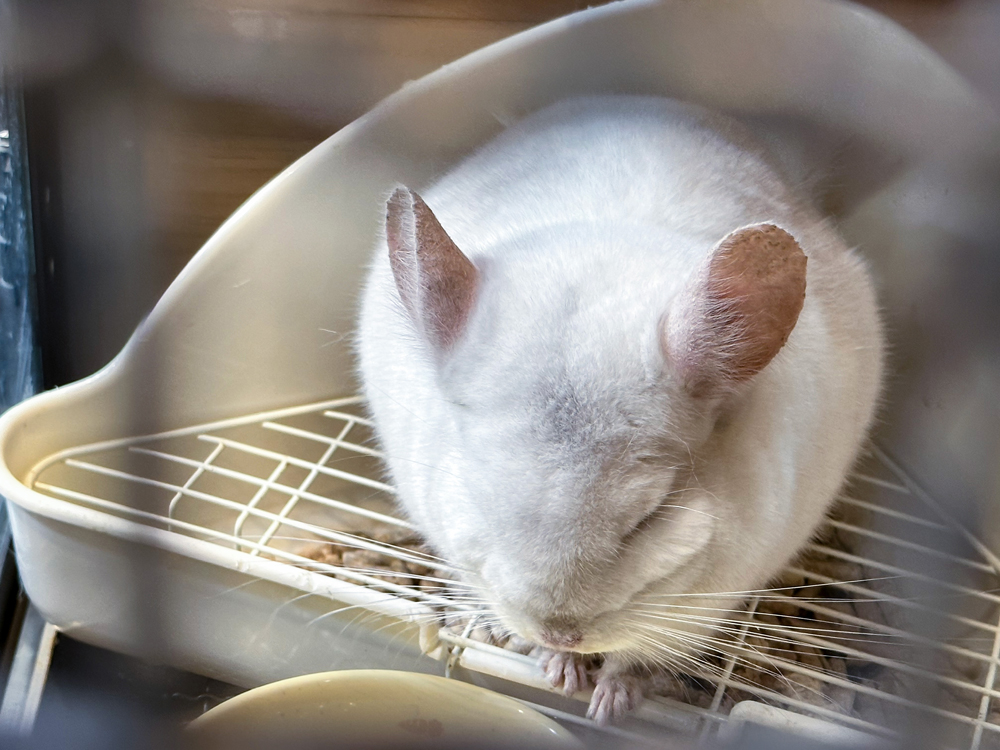
Chinchillas are another type of rodent, similar to rats. Chinchillas are known for their irresistibly soft fur and active, playful personalities.
Originating from the Andes Mountains in South America, these animals are nocturnal and have a strong instinct to explore and play, particularly during twilight and dawn. Therefore, they require a spacious and secure cage with plenty of toys and exercise options to satisfy their curious and active nature.
Chinchillas have quite a unique method of bathing shared with degus and gerbils. They don’t bathe in water – instead, they take dust baths! The dust keeps their fur clean and soft, and is an essential aspect of their hygiene that mirrors their natural behavior in the wild.
In terms of care, chinchillas require a significant commitment from their owners. We give them a care difficulty rating of ⭐⭐⭐⭐ 4/5 stars (quite difficult!). They need a carefully regulated diet, spacious and enriched living environment, and regular, careful handling to maintain socialization.
They also have a longer lifespan than many other pocket pets, often living up to 10-15 years, which is a longer term commitment than many people expect from such a small pet!
For a more comprehensive comparison of chinchillas and pet rats, please read our detailed article: Face-Off of The Furballs: Pet Rats vs. Chinchillas.
2. Sugar Gliders
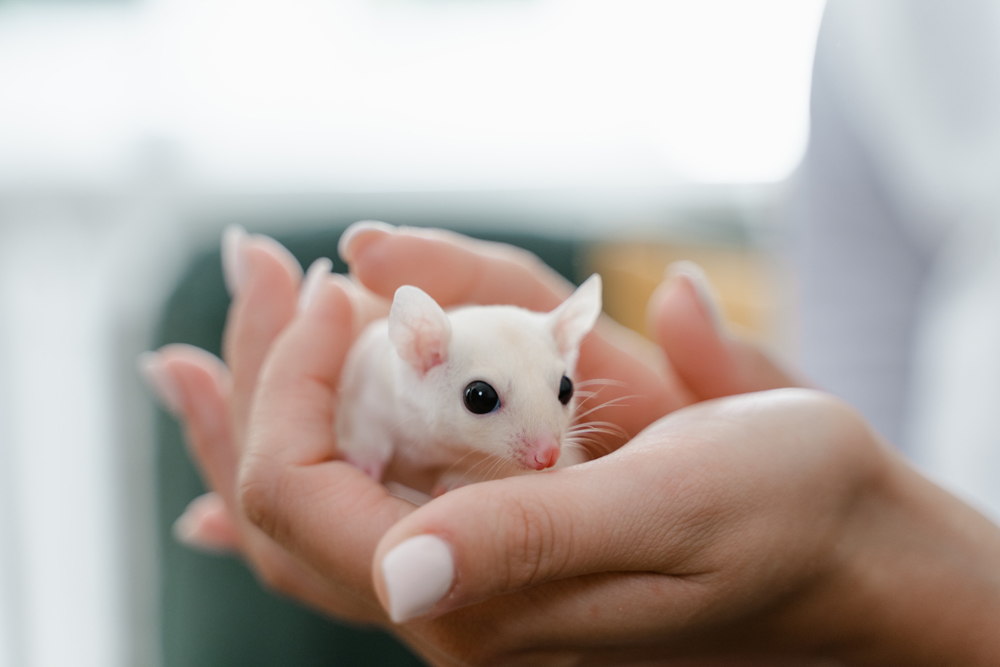
Sugar Gliders are small, exotic marsupials that are becoming more and more popular as pets. Originating from Australia, Indonesia, and New Guinea, these animals are known for the skin flaps between their wrists and ankles that they stretch out to glide from tree to tree in the wild.
In the wild, Sugar Gliders live in family groups of up to seven individuals. As pets, they also do best in pairs or groups, as a solitary Sugar Glider can become lonely and depressed.
When it comes to caring for a Sugar Glider, the difficulty level is the highest on this list, with a rating of ⭐⭐⭐⭐⭐ 5/5 stars.
Sugar gliders have very specific dietary needs that include a variety of live insects, sugary fruits and calcium supplementation. They can develop all kinds of health conditions from malnutrition if you don’t get their diet right!
Their social nature means they require plenty of interaction and socialization, and they do best when kept in pairs or groups, which means more space is needed. Sugar gliders are also physically very delicate, can easily get injured if you drop them, and can perish within 12 hours if they get dehydrated.
For a more comprehensive comparison of Sugar Gliders and pet rats, here is a detailed article: Pet Rats vs. Sugar Gliders.
3. Ferrets
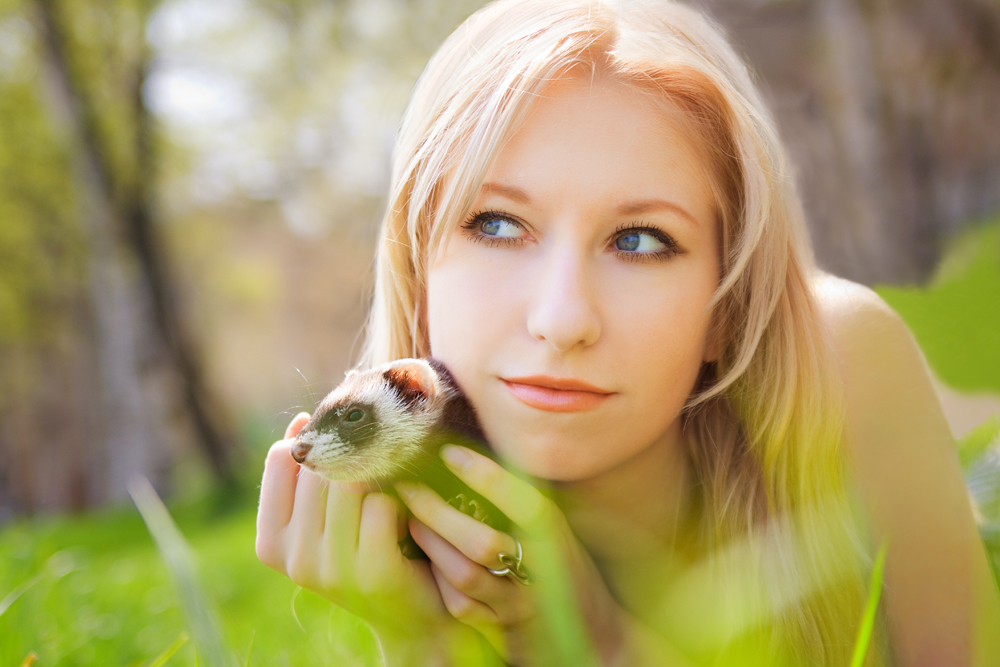
Many of my friends who found pet rats’ short lifespan too depressing decided to get ferrets instead. They’re almost like a long rat, right? (They’re actually a natural predator!) As an added bonus, they live 7-10 years on average.
Ferrets are lively and intelligent, and known for their extremely goofy, playful and curious nature. They’re larger than most pocket pets, and the size, combined with their high energy level, means they need plenty of space to explore and play.
Ferrets also need to spend a lot of time outside of their cage. 4 hours is usually the recommended minimum, but ideally more than that. They are less like a pocket pet in that respect and more like a dog or cat.
Ferrets are also highly social animals and can form strong bonds with their human caregivers, providing endless entertainment and companionship. They are hardy enough that they can get along some cats or dogs, with supervision.
One interesting characteristic of ferrets is the way they play and hunt, referred to as the ‘weasel war dance.’ This includes silly hops, sideways jumps, and clumsily bumping into nearby objects. It’s hilarious to watch and a sign of a happy ferret.
When it comes to their care, ferrets have a fairly high difficulty rating, with ⭐⭐⭐⭐ 4/5 stars. Their diet is primarily carnivorous and should consist of high-quality ferret food or raw meats.
Ferrets need a large, multi-level cage, but also need several hours of supervised playtime outside their cage every day. They are prone to certain health issues and require regular veterinary care, including rabies vaccinations and check-ups.
Ferrets are one of the few pets on this list that you can safely take for walks outdoors, using a ferret harness. As a downside, they are probably one of the smellier pets on this list, with natural, musky scent glands. (Some ferrets are de-scented before they are adopted out.)
For a detailed comparison between ferrets and pet rats, check out our comprehensive article: Rats vs. Ferrets: Which Makes a Better Pet?.
4. Rabbits
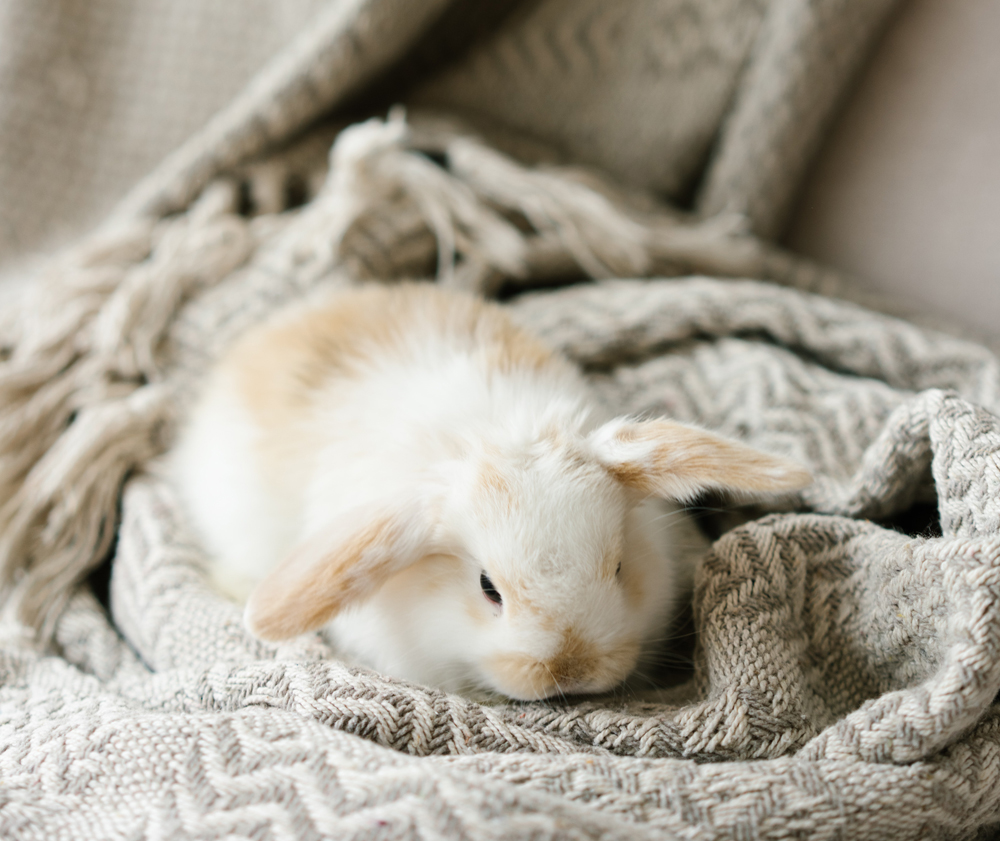
Rabbits are wonderful and interactive pets that can form strong bonds with their human caregivers. Known for their soft fur, long ears and big feet, rabbits are social animals that crave companionship and stimulation.
They love to play with toys and explore their surroundings, which means they need a spacious habitat and regular supervised time outside their cage to hop around.
A unique trait of rabbits is their burrowing ability. In the wild, rabbits create complex burrow systems, known as warrens, for shelter and protection. This instinct can translate to a pet setting as well, and your rabbit might enjoy having a hideaway or tunnel in its habitat to satisfy this natural behavior.
As for their care, rabbits earn a rating of ⭐⭐⭐ 3/5 stars. Their diet does need to be balanced and should include a mix of hay, fresh vegetables, and rabbit pellets. They require regular mental stimulation and social interaction to keep them happy. Dental problems are quite common in rabbits, and they may need regular trips to the vet to file down their teeth if they get misaligned.
For a more in-depth comparison between rabbits and pet rats, take a look at our detailed article: Pet Rats or Rabbits?.
5. Degus
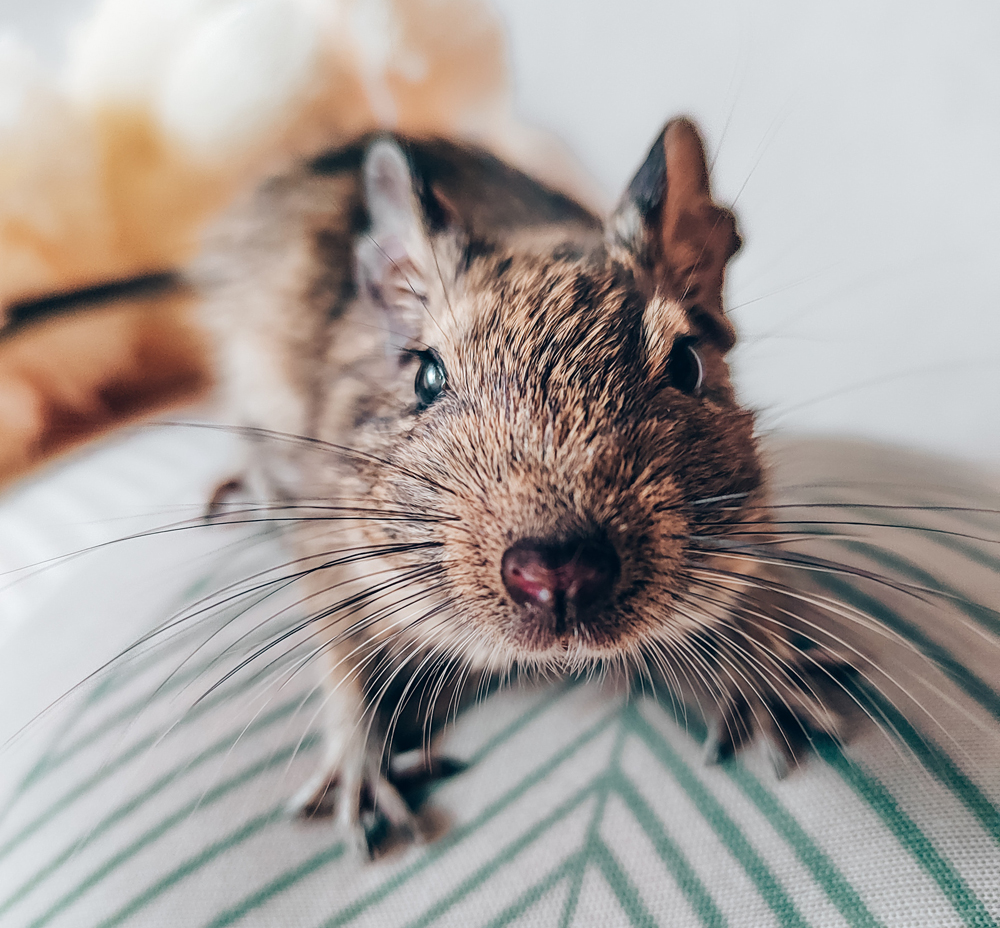
Degus are active and sociable rodents originally from Chile. They are closely related to chinchillas and guinea pigs, and share some similarities with both.
Degus are intelligent, enjoy social interaction, and need to live with at least one other Degu to prevent loneliness and stress.
Degus are able to vocalize a wide variety of sounds for different situations. They can make up to 15 different vocal sounds, including warning calls and communication with their companions, making them one of the more vocal small pets.
When it comes to caring for a Degu, they get a difficulty rating of ⭐⭐⭐ 3/5 stars. Degus require a balanced diet primarily consisting of hay, with a small portion of high-quality degu-specific pellets, and occasional fresh vegetables. They need a spacious cage with plenty of enrichment activities, as they are active and intelligent animals that love to explore and play.
For a more comprehensive comparison of Degus and pet rats, you can read our detailed article: Pet Rats vs. Degus.
6. Guinea Pigs
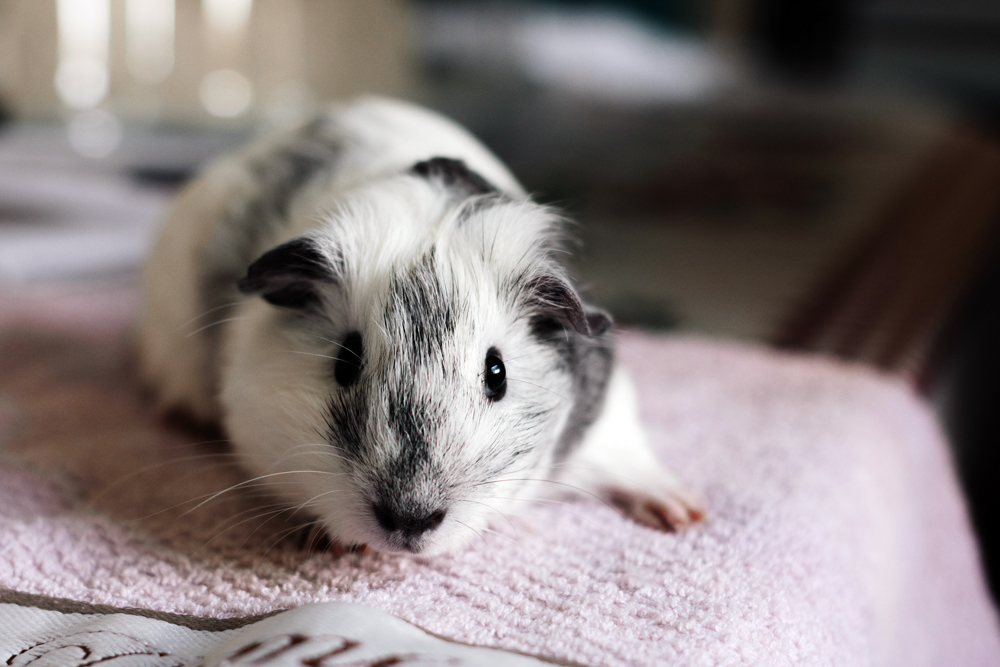
Guinea Pigs, also known as cavies, are friendly and responsive pets known for their unique vocalizations and sociable nature.
Guinea pigs are very docile, making them a popular choice for families with young children. They enjoy social interaction and thrive in pairs or small groups, so it’s often recommended to have more than one.
One of the most endearing traits of Guinea Pigs is their unique vocalization, often referred to as a “wheek.” They make this sound when they’re excited, such as during feeding time, when they hear their favourite person’s voice, or when they want attention.
In terms of care, Guinea Pigs have a difficulty rating of ⭐⭐ 2/5 stars. Their diet primarily consists of hay, supplemented with fresh vegetables, fruits, and specially designed Guinea Pig pellets. They require a roomy cage and love to have plenty of toys and tunnels to play with. They also aren’t super prone to health issues, though there are some common things to watch out for.
Despite their needs being relatively straightforward, they still require time and attention from their owners for feeding, cleaning, and social interaction.
To compare Guinea Pigs with pet rats more thoroughly, check out our in-depth article: Rats or Guinea Pigs: A Side-by-Side Look.
7. Hedgehogs
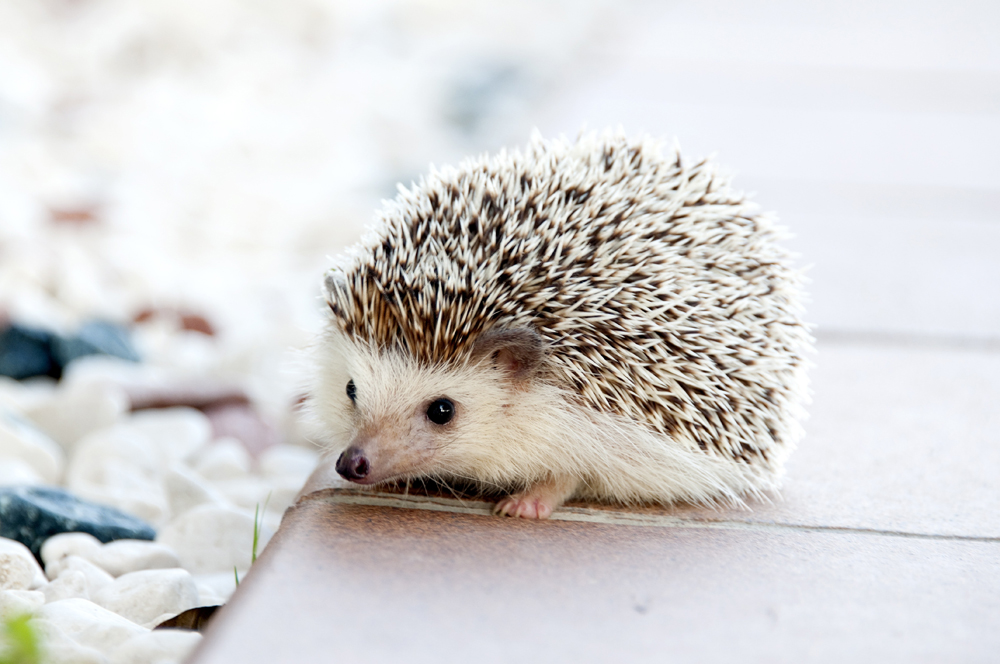
Hedgehogs are unique pets, widely recognized for their spiny coats and cute, grumpy faces. These solitary creatures are primarily nocturnal, and unlike most of the other animals on this list, they have very little interest in adjusting their schedule to suit yours!
Although they might seem a bit standoffish at first, hedgehogs can get used to human handling over time with gentle and consistent interaction.
They’re not quite as cuddly as other animals on this list, having quills! While they certainly aren’t as prickly as a porcupine, those quills can still be pretty pokey, especially when they’re standing on end.
When it comes to their care, hedgehogs are some of the trickier animals to care for with a rating of ⭐⭐⭐⭐ 4/5 stars. They do have some specific needs, like a constant heating source to prevent hibernation, a varied diet including live insects, and regular handling to balance out their antisocial nature.
Hedgehogs are also one of the messier animals on this list. They pee and poo when they run, and often need your help cleaning their waste out of their quills and fur.
For a more in-depth comparison between hedgehogs and pet rats, check out our detailed article: Rats vs. Hedgehogs: Which One Will Win Your Heart?.
8. Hamsters
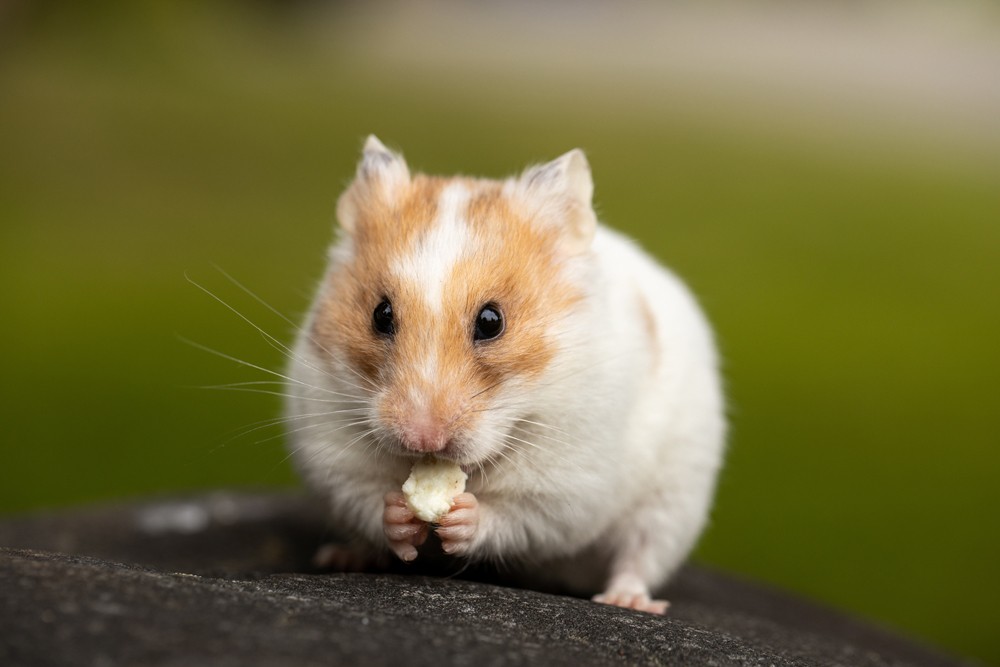
Hamsters are popular small pets due to their size, low-maintenance care, and cute faces. Most active during the evening and night, they’re known for their love of running on wheels and storing food in their cheek pouches.
Hamsters are not super social, and don’t always love being handled. They are probably the most likely to bite out of any animal on this list, but their teeth aren’t as big or strong!
In terms of care, hamsters earn a difficulty rating of ⭐⭐ 2/5 stars. They need a well-balanced diet of hamster pellets, fresh fruits, vegetables, and occasional proteins.
Despite being solitary animals, they still require regular interaction and a variety of toys for enrichment. Their small size means they don’t need as much space as some of the other pets on this list.
For a more in-depth comparison between hamsters and pet rats, check out our detailed article: Pet Rats vs. Hamsters.
9. Gerbils
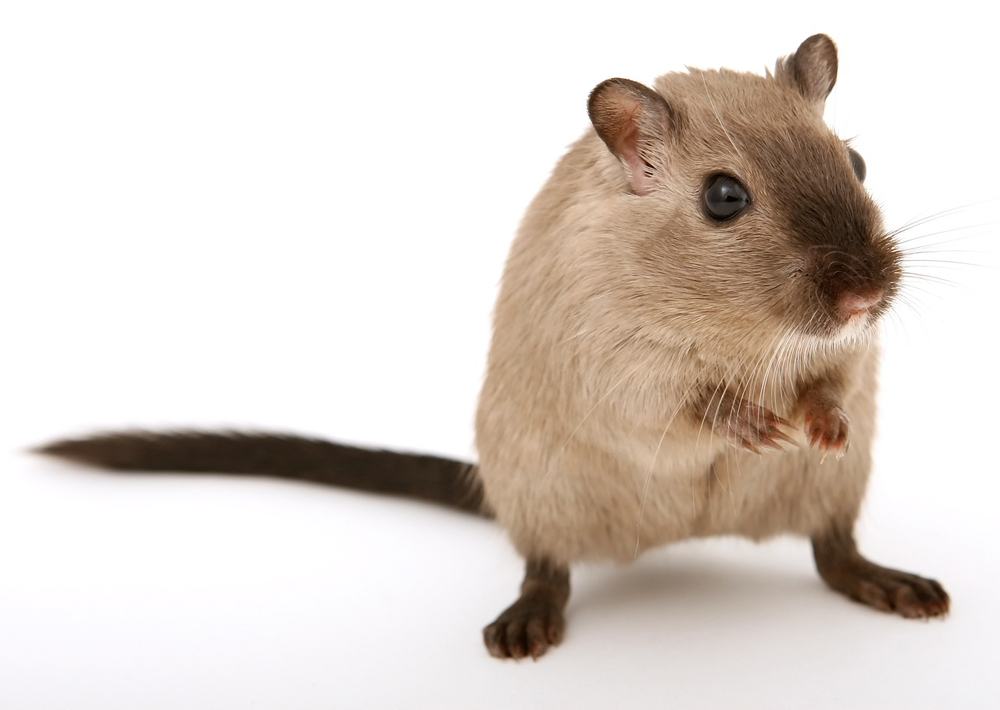
Gerbils are small, active rodents known for their love of burrowing and digging. They’re social animals, and like many others on this list, they thrive when living with a companion. Originating from desert environments, gerbils have adapted to be hardy and low-maintenance pets, who don’t drink or pee as much as others on this list!
An interesting behavior gerbils exhibit is called ‘thumping.’ When they get excited or stressed, gerbils will rapidly drum their hind legs on the ground. This behavior is a form of communication or a warning between gerbils and is neat to observe.
In terms of care, gerbils are relatively easy to look after, earning a difficulty rating of ⭐⭐ 2/5 stars. They have a diet of gerbil-specific pellets and occasional fresh fruits and vegetables. Their cage should include lots of deep bedding for burrowing, along with various toys and tunnels for enrichment. Though they’re low maintenance, they still require regular interaction and careful handling due to their small size and quick movements.
For a detailed comparison between gerbils and pet rats, delve into our comprehensive article: Rats vs. Gerbils.
10. Mice
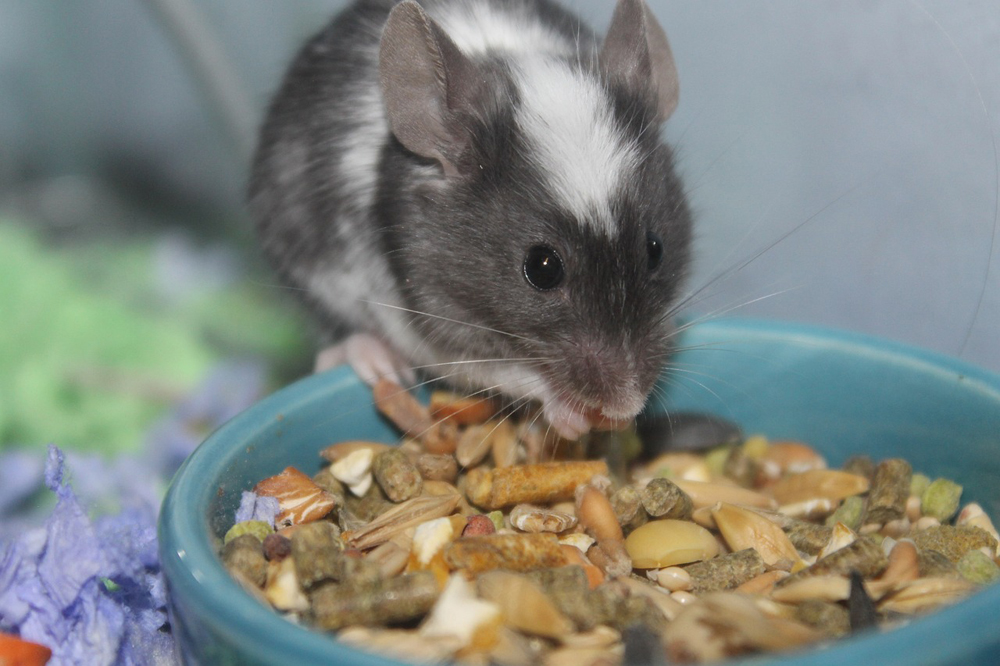
Mice are tiny, curious creatures that make delightful, but short lived pets. They are social animals that thrive when living in small groups. Highly active and agile, mice love to climb, explore, and play, making them fun and entertaining to watch.
Despite their small size, mice can jump as high as a foot in the air! This is one of the many ways they show their agility and it can be quite a surprise when you first see it.
As for their care, mice receive a difficulty rating of ⭐⭐ 2/5 stars. Their diet consists of a mix of mouse-specific pellets and a variety of fresh fruits and vegetables. They need a secure cage with space for stretching their little legs, along with different toys and materials for enrichment.
While they’re generally easy to care for, they do require regular interaction and socialization. Mice are also known for being quite a lot stinkier than other small pets, in spite of their size.
For a more comprehensive comparison of mice and pet rats, please read our detailed article: Team Rat or Team Mouse: Find the Best Pet for You.
The Pocket Pet Awards
Different pocket pets can look more appealing, depending on what you’re looking for! Let’s see who wins in each category.
🏆 The least smelly pocket pet
Of this list, personally I would say the chinchilla is the least smelly of all the pocket pets, with ferrets being the most smelly by far! (Unless they have been de-scented.)
Keep in mind that all of the pets on this list live in cages, so if you don’t keep them clean, they will start to smell like their own pee. Regardless of which animal you choose, leaving them too long in between cage cleanings can cause odours and health problems.
🏆 Pocket pets you can keep alone
Many of the pocket pets on this list need to be kept in pairs or small groups to be happy, because that’s how they live in the wild.
Hedgehogs and hamsters are the exception to this rule. If your parents or landlord are only letting you get one pet, they might be the perfect pocket pet for you!
🏆 Pocket pets you can keep outside
Many of the pets on this list are extremely sensitive to temperature changes – mainly heat, but sometimes cold too. So they can’t live outside, and typically shouldn’t go outdoors at all.
Bunnies, guinea pigs, and ferrets can happily live outdoors though, given the right enclosure. Ideally, it would be securely fenced in and include a roof or ceiling, because even pets of that size can get picked up by hawks.
Pets should always have protection from extreme weather, thunder storms, and predators. Some people build a “run” in their back yard attached to their house, with a cat door so their pets can come inside and outside whenever they want.
🏆 Pocket pets with the longest lifespan
The chinchilla tops our list of long lived pocket pets, with an expected lifespan of 10 to 20 years! Sugar gliders come in a close second at 10 to 12 years.
The downside to these long-lived pets is that they’re both quite delicate. Sugar gliders require a very specific diet (including insects) and can die from dehydration faster than any other animal on this list. Chinchillas are extremely prone to heat stroke during hot weather because of their thick coats! Both animals are also very fragile in terms of handling and potential for injuries.
Rabbits and ferrets also have fairly long lifespans of about 7-10 years. These animals are a little bigger-boned, but also have lots of potential health care concerns that can have you quickly racking up the vet bills! Rabbits are very prone to dental issues needing regular maintenance, while ferrets like to eat things they shouldn’t and end up with intestinal blockages. Female ferrets also need to be spayed to prevent them from developing a fatal medical condition.
Degus, guinea pigs and hedgehogs have medium-length lifespans. They make great pets for kids around 10-12 years old, as they can stay with you through your teenage years without necessarily coming with you to college. (Most dorms don’t allow pets!)
Rats, hamsters and gerbils sadly have pretty short lifespans between 2 and 4 years. That can be a good thing when you aren’t sure what the future holds, and just want a pet for the meantime.
The humble mouse has the shortest lifespan of any pet on this list, living only 1-2 years on average. For this reason, and because they’re such social critters, many people keep them in groups.
🏆 Easiest pocket pets to care for
The easiest pocket pets to care for are hamsters and mice. These animals don’t need large cages, don’t have extensive specialized care needs like a super specific diet, extra grooming, or a dedicated heat source, and wont be offended if you forget to take them out of their cage today (in fact, they might even be happy that you left them alone!)
Hamsters may be the easiest pet of all because they are one of very few pocket pets who prefers to live alone. Most other pocket pets, including mice, are a package deal because they’re so used to living in colonies in the wild.
Rats are quite easy to care for, in terms of their cage requirements, maintenance level, and no need for specialized grooming. But they can definitely demand more attention than a mouse or hamster, and easily get bored and depressed if not given enough time with their owner, opportunities to explore their environment, and enrichment items inside their cage.
🏆 Most Affectionate Pocket Pets
While all of these pocket pets will technically hang out with you if you make them, only some of them are actually curious and affectionate towards their humans.
Pet rats are well known for being very affectionate, almost like dogs – they will climb all over you, lick you, and even groom you as if you were another rat!
Chinchillas, degus, ferrets, sugar gliders, guinea pigs and rabbits are also known for being very sociable and lovable pets who actually enjoy spending time with you, rather than just tolerating you!
Hedgehogs and hamsters are some of the least social of all pets on this list. While you can tame them by handling them a lot, for the most part they prefer to keep to themselves.
Conclusion
I hope this article helped you pick out the perfect pocket pet for you! From the longest lifespan, where chinchillas and sugar gliders take the lead, to the easiest pets to care for like hamsters and mice, each animal brings something unique to the table!






